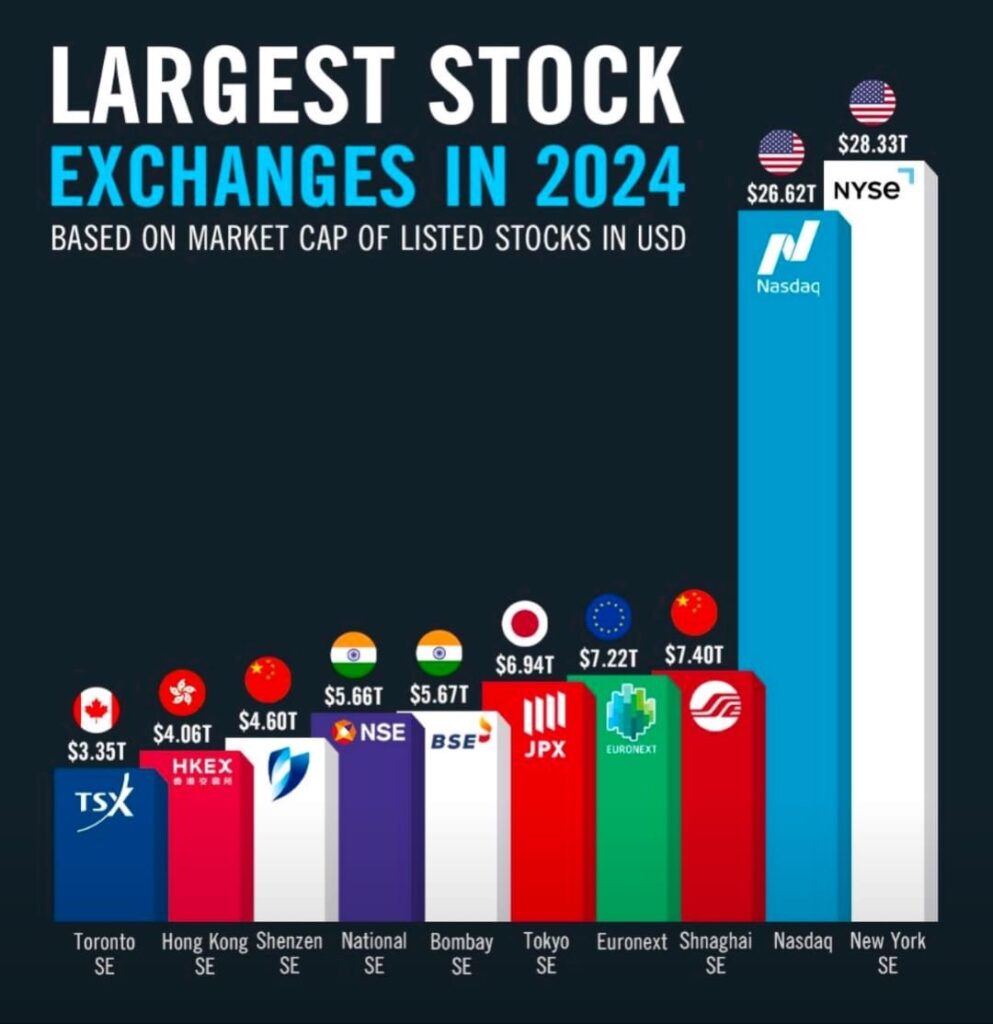Global Stock Exchanges in 2024: India’s Rise Among the Giants
The global stock market hierarchy provides a fascinating insight into the distribution of wealth across major stock exchanges. As of 2024, the data reveals the dominance of the US markets while highlighting the impressive rise of India, which now ranks among the top exchanges globally. This positions India as a potential key player in the coming decades.

The Largest Stock Exchanges by Market Cap
New York Stock Exchange (NYSE): At the top of the list, the NYSE boasts a staggering market cap of $28 trillion, reflecting its dominance as the world’s largest and most influential stock exchange.
Nasdaq: Following closely, Nasdaq’s market cap of $26.66 trillion underscores the immense value created by US tech giants over the last decade.
Shanghai Stock Exchange: Representing China, Shanghai holds third place with a market cap of $7.4 trillion.
Euronext: The Eurozone’s combined exchange ranks fourth with $7.22 trillion, just behind Shanghai.
Tokyo Stock Exchange (TSE): Japan takes the fifth spot with a market cap of $6.94 trillion.
India’s NSE and BSE: The combined market cap of India’s National Stock Exchange (NSE) and Bombay Stock Exchange (BSE) stands at $5.6 trillion, ranking sixth globally.
India’s Rising Position in Global Markets
India’s NSE and BSE are steadily climbing the ranks. The country’s combined market cap now exceeds many established markets, placing it firmly in the top six. Here’s why this growth is significant:
Demographic Dividend: India’s young and growing population provides a strong foundation for economic expansion.
Expanding Middle Class: A rising middle class with increasing disposable income is fueling consumption and investment.
Innovation and Entrepreneurship: India is seeing a surge in startups and tech innovations, contributing to market growth.
Favorable Reforms: Policy changes, infrastructure development, and ease of doing business have attracted global capital.
India’s Potential to Leapfrog
By the end of this decade, India has the potential to overtake markets like Japan, Euronext, and even Shanghai, moving closer to the US in market cap rankings. This projection is based on:
Sustained GDP growth rates.
Continued foreign direct investment (FDI).
Increasing participation from retail investors.
Development in key sectors such as technology, finance, and manufacturing.
Lessons for Indian Investors
Stay Invested in Indian Markets: Despite concerns about valuations or short-term volatility, India’s long-term potential remains robust.
Follow Market Trends: Use strategies aligned with market cap growth and price movements to ensure you don’t miss out on significant opportunities.
Diversify Globally: While India is rising, exposure to other top markets like the US provides a balanced portfolio.
WeekendInvesting launches – PortfolioMomentum Report
Momentum Score: See what percentage of your portfolio is in high vs. low momentum stocks, giving you a snapshot of its performance and health.
Weightage Skew: Discover if certain stocks are dominating your portfolio, affecting its performance and risk balance.
Why it matters
Weak momentum stocks can limit your gains, while high momentum stocks improve capital allocation, enhancing your chances of superior performance.
Disclaimers and disclosures : https://tinyurl.com/2763eyaz










